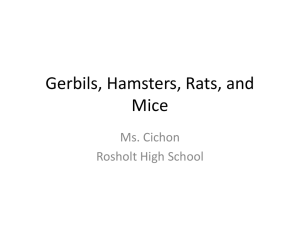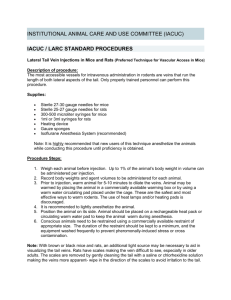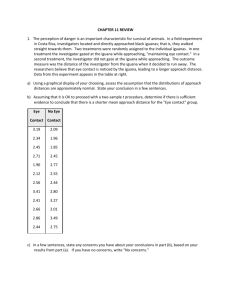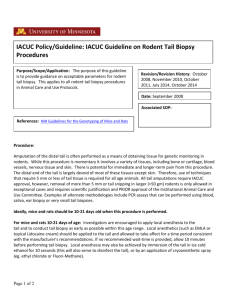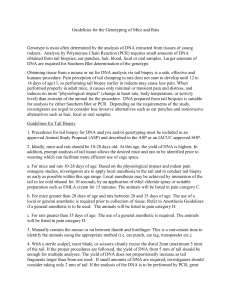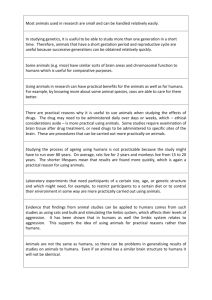Number 1 - Laboratory Animal Boards Study Group
advertisement
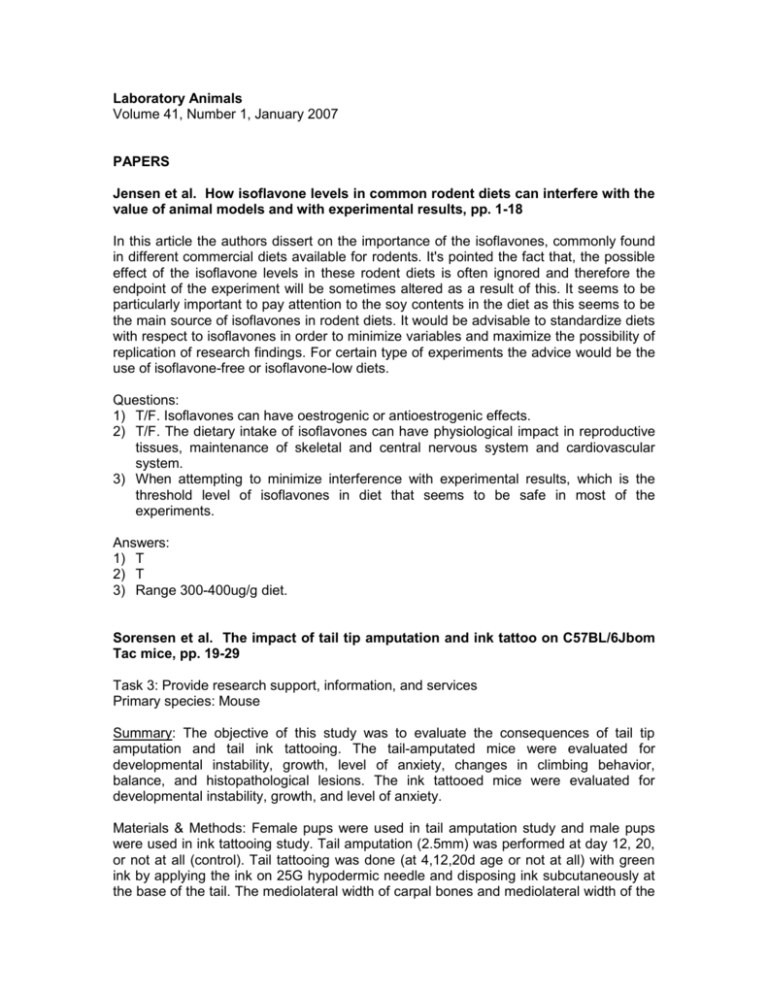
Laboratory Animals Volume 41, Number 1, January 2007 PAPERS Jensen et al. How isoflavone levels in common rodent diets can interfere with the value of animal models and with experimental results, pp. 1-18 In this article the authors dissert on the importance of the isoflavones, commonly found in different commercial diets available for rodents. It's pointed the fact that, the possible effect of the isoflavone levels in these rodent diets is often ignored and therefore the endpoint of the experiment will be sometimes altered as a result of this. It seems to be particularly important to pay attention to the soy contents in the diet as this seems to be the main source of isoflavones in rodent diets. It would be advisable to standardize diets with respect to isoflavones in order to minimize variables and maximize the possibility of replication of research findings. For certain type of experiments the advice would be the use of isoflavone-free or isoflavone-low diets. Questions: 1) T/F. Isoflavones can have oestrogenic or antioestrogenic effects. 2) T/F. The dietary intake of isoflavones can have physiological impact in reproductive tissues, maintenance of skeletal and central nervous system and cardiovascular system. 3) When attempting to minimize interference with experimental results, which is the threshold level of isoflavones in diet that seems to be safe in most of the experiments. Answers: 1) T 2) T 3) Range 300-400ug/g diet. Sorensen et al. The impact of tail tip amputation and ink tattoo on C57BL/6Jbom Tac mice, pp. 19-29 Task 3: Provide research support, information, and services Primary species: Mouse Summary: The objective of this study was to evaluate the consequences of tail tip amputation and tail ink tattooing. The tail-amputated mice were evaluated for developmental instability, growth, level of anxiety, changes in climbing behavior, balance, and histopathological lesions. The ink tattooed mice were evaluated for developmental instability, growth, and level of anxiety. Materials & Methods: Female pups were used in tail amputation study and male pups were used in ink tattooing study. Tail amputation (2.5mm) was performed at day 12, 20, or not at all (control). Tail tattooing was done (at 4,12,20d age or not at all) with green ink by applying the ink on 25G hypodermic needle and disposing ink subcutaneously at the base of the tail. The mediolateral width of carpal bones and mediolateral width of the joint between tibia and tarsal bones on skin of conscious animals was measured at 17, 24, 38 & 59 days of age to evaluate fluctuating asymmetry (FA). All mice were tested for anxiety during dark period in the light/dark box paradigm. Mice were also observed for climbing behavior & tail biting at 30 min after tail biopsy. The tail amputated mice were also tested in balance beam walking test at eight wks of age. These mice were euthanized seven weeks after tail amputation for histopathological examination of tails. Results & Discussion: Mice subjected to tail tattooing showed traces of ink in the feces several days after procedure, which was probably due to ingestion of ink by licking. Body weight and behavior in light-dark box was not influenced by tail amputation or tail ink tattooing. But an effect of cage was noted on these parameters in both studies. Tail amputation resulted in a transient increase in FA but tail amputation did not. Tail amputation reduced climbing behavior for short period of time in day 20 group only. Tail biopsy did not influence balance beam walking test. The measures of growth and fearrelated behavior were influenced by cage indicating that social environment within each cage affects these factors to a higher extent than it affects FA. The histopathology revealed moderate to severe hyperkeratosis in the amputated tails. Some samples showed nil to minimal degree of hyperkeratosis. At seven wks after tail amputation, a significant number of mice did not have fully regenerated skin glands and hair follicles in the tail. Questions: 1) Developmental instability of the individual due to environmental or genomic stress in growing animals is commonly monitored as ___________. 2) This study found development of neuromas as a consequence of tail amputation in mice. T/F 3) Which of the following statement is true: a) Both tail amputation and tail tattooing influenced fluctuating asymmetry. b) Tail amputation influenced fluctuating asymmetry whereas tail tattooing did not. c) Tail tattooing influenced fluctuating asymmetry whereas tail amputation did not. d) Both tail amputation and tail tattooing did not affect fluctuating asymmetry. Answers: 1) Fluctuating asymmetry 2) False. Neuromas have been reported in pigs and dogs after tail docking. 3) C. Should laboratory mice be anaesthetized for tail biopsy?, pp. 30-45 Summary: The aim of this study was to assess the effect of a single tail biopsy for genotyping on physiological and behavioural parameters of adult mice and whether anaesthesia during the process can be beneficial. The researchers looked at bodyweight curves, daily food/water consumption and telemetric measurements of heart rate, core body temperature and locomotor activity for 3 days following tail biopsy with and without anaesthesia with methoxyflurane and ether. Tail biopsy without anaesthesia led to an increase in heart rate and locomotor activity for one hour and an elevated body temperature for 2 hours. With anaesthesia heart rate was increased for 4 hours afterwards. Core body temperature remained elevated for 20h after exposure to ether and for 44 hours after exposure to methoxyflurane. Methoxyflurane also slightly reduced bodyweight. Deaths did occur under ether anaesthesia at a rate of 7%. The results indicate a short lived effect of the tail biopsy procedure whereas anaesthesia caused alterations in the indices measured. It is suggested that anaesthesia for tail biopsy (with these agents) does not improve mouse welfare. Questions 1. True/False- Tail biopsy causes measurable changes in physiological and behavioural parameters (that give an indication of level of well-being). 2. True/False- Deaths were recorded with both anaesthetic agents used in this experiment. 3. True/False- Anaesthesia appeared to reduce physiological and behavioural effects on tail biopsied animals. 4. The results of this study suggest that: a. Anaesthesia during tail biopsy results in improved welfare for mice following the procedure. b. Anaesthesia provides no benefit to mice in terms of improved welfare. c. Anaesthesia with ether or methoxyflurane provides no benefit to mice in terms of improved welfare. Answers 1. T 2. F- Deaths were only recorded with use of ether. 3. F 4. c Richardson et al. Evaluation of the efficacy of a novel electronic pain assessment device, the Pain Gauge, for measuring postoperative pain in rats, pp. 46-54 Task 2 - Prevent, alleviate, and minimize pain and distress Primary Species - Rat Summary: This article utilizes the Pain Gauge and attempts to determine if it is effective in assessing postoperative pain in rats. A clinical trial was performed using rats that received a surgical procedure, and rats that underwent an anesthesia only treatment. All rats received either a high or low dose of NSAIDs. There was no overall increase in postoperative pain scores in rats that were most likely to suffer from postoperative pain compared with rats that did not undergo a potentially painful procedure. The authors concluded that the Pain Gauge is ineffective in assessing postoperative pain in rats in this study. Questions: 1. T or F Clinical pain is highly variable. 2. The Pain Gauge is a(n) _______________________pain assessment device that measures ______________________________. 3. Define EDA 4. The pain score of rats in the low dose analgesic groups were_______when compared to the high dose analgesic group. a) Significantly different b) Not significantly different c) Significantly the same d) Not significantly the same 5. T or F. An increase was seen in pain scores post surgically 6. Provide a possible explanation for why the Pain Gauge was ineffective at assessing pain in this study. Answers: 1. True 2. Objective, electrodermal activity 3. Refers to changes in electrical conductance of the skin that result from sympathetic neuronal activity 4. B 5. False 6. None of the rats were in pain, Pain Gauge not used effectively, Pain Gauge does not measure EDA, or EDA not proportional to pain. Lehmann et al. Ketamine does not affect intestinal microcirculation in pentobarbital-anaesthetized rats during experimental endotoxaemia, pp. 55-62 Species: Lewis rats Objective: To evaluate the effects of ketamine on intestinal microcirculation in pentobarbital-anaesthetized rats during experimental endotoxaemia. Most anaesthetics may interact in some way with the immunological pathways affecting microcirculation and thus influence the experimental results in microcirculatory models necessary in experimental sepsis research. Changes within the intestinal microcirculation were examined and compared with intravital fluorescence microscopy (IVM) to estimate functional capillary density (FCD) and leukocyte adherence. The effects of the IV anaesthetics were evaluated within the intact and altered microcirculation respectively. To induce microcirculatory changes comparable to septic conditions, E. coli lipopolysaccharide (LPS) was administered. Blood levels of the cytokines tumour necrosis factor (TNF)-alpha, interleukin (IL)-1 Beta, IL-6 and IL-10 were evaluated to determine whether the anesthetic agents affected the cytokine release in experimental endotoxaemia. In this study, IV anaesthesia with pentobarbital in combination with ketamine did not alter intestinal FCD, leukocyte behaviour and cytokine release in healthy animals and during endotoxaemia in comparison to the sole use of pentobarbital anaesthesia. Conclusion: This anaesthetic model can be reliably used to study endotoxaemic alterations within the intestinal microcirculation of the rat. Question: 1. What values were evaluated to determine if ketamine affected the cytokine release in experimental endotoxaemia? Answer: 1. Blood levels of the cytokines tumour necrosis factor (TNF)-alpha, interleukin (IL)-1 beta, IL-6 and IL-10 Djelmami-Hani et al. Induction of heart failure: haemodynamic comparison of three different canine models, pp. 63-70 ACLAM TASK - 3 & 9 ACLAM SPECIES DESIGNATION – Primary species (dog) Summary: Congestive heart failure manifests itself in many marked anatomical and biochemical changes of the myocardium. These pathological adaptations include ventricular dilatation and dysfunction combined with increased systemic vascular resistance. In the US the prevalence of chronic heart failure has risen to approximately 4-5 million people with 400,000 new cases occurring annually. Experimental models of chronic heart failure assist in the evaluation of new medical and surgical therapies. The animal model chosen to study this disease process must resemble the human model in structure and function, both in the normal and diseased states. Larger animals have anatomical and hemodynamical characteristics similar to humans, making them suitable models for investigating surgical options in humans. In this study the group compared three methods of inducing heart failure: arteriovenous anastamosis, doxorubicin administration, and combination of anastamosis and doxorubicin. Their intentions were to design a simple, stable model of chronic heart failure. The dogs were divided into three groups each group receiving one of the above mentioned protocols. Animals were followed for eight weeks and fifteen different hemodynamic parameters were tracked and compared to baseline values. Results showed that eight weeks are not enough to produce stable heart failure using arteriovenous anastamosis alone. Doxorubincin administration alone produces a left ventricular failure. Alternatively, using a combination of both of these interventions provides a more stable model of right- and left-sided heart failure. Questions 1. What is the pathogenesis of doxorubicin toxicity? 2. What are some other agents that can be used to induce toxic cardiomyopathy? Answers 1. It is found to be multifactorial, and it generally leads to degenerative changes in the myocardium with myofibril loss, altered synthesis of nucleic acids and mitochondrial respiration, formation of free radicals and release of histamine and catecholamine. 2. Imipramine, furazolidone, emitine, cyclophosphamide, and high concentrations of glucose Bunger et al. Anastomotic stenting in a porcine aortoiliac graft model, pp. 71-79 ACLAM TASK - 3 & 9 ACLAM SPECIES DESIGNATION – Primary species (pig) Summary: Purpose of the study was to evaluate the feasibility of anastomotic stent application in a porcine aortoiliac graft model. In 10 pigs, a polytetrafluoroethylene aortobi-iliac graft was implanted through a midline abdominal incision. The lower edge of the iliac vessel was graft-inverted about 1mm to produce irregularities at the downstream anastomosis. After transverse graft incision, six stainless-steel stents, six poly-L-lactic acid (PLLA) stents and four PLLA stents with 10% polycaprolactone (PCL) were implanted at the iliac anastomotic site using a 6mm balloon dilation catheter. Four anastomotic sites were left untreated. After 2 weeks, the patency of graft limbs was evaluated by contrast-enhanced computed tomography (CT). On CT scan, all metal and PLLA-stented graft limbs were free of stenosis, whereas all PLLA/PCL stents were occluded. The non-stented graft limbs showed a stenosis of 50-70%. An important cause of bypass graft failure is acute dissection and late stenosis at the downstream anastomosis. Metal stents can be used to prevent acute dissection, but metal induces by itself local thrombosis and restenosis due to intimal proliferation. Biodegradable polymer stents may overcome the neointimal hyperplasia. All animals received aspirin therapy one day prior to surgery and IV heparin as a continuous infusion during the procedure. Femoral artery blood flow was measured by doppler ultrasound prior to and after procedure. At 2 weeks, femoral blood flow of metal and PLLA stented graft limbs was comparable to flow before graft placement. In contrast, the femoral blood flow was significantly diminished in the PLLA/PCL and non-stented group. Questions: 1. T or F. Metal stents were comparable to PLLA polymer stents at 2 weeks post placement in terms of stenosis in graft limbs. 2. T or F. Graft inversion of the iliac vessel was used to create a more stable anastomosis. 3. T or F. Doppler ultrasound was useful to measure femoral artery flow before, during and after stent placement. Answers: 1. T 2. F Used to create downstream irregularities 3. T Kaiser et al. Method of intracranial pressure monitoring and cerebrospinal fluid sampling in swine, pp. 80-85 Task 9- Collaborate on the Selection and Development of Animal Models species: Primary/Pig (Sus scrofa) Summary: Cerebral oedema and encephalopathy have been noted to occur frequently in patients severely ill or dying after trauma, ischaemia, infections or even metabolic disorders. The objective of the present study was to establish continuous monitoring of the intracranial pressure (ICP) and sampling of cerebrospinal fluid (CSF) for further investigations in swine. ICP monitoring was established in eight pigs by using a ventricular drainage system, implemented after paramedian trepanation of the os frontale. CSF and serum samples were taken for measurement of the levels of glucose and protein. Operating time was 21+/-8 min for the trepanation until ICP monitoring was performed. No complications occurred during surgery. Continuous monitoring of ICP and CSF sampling was easy to perform, and without any side-effects in any animal. At autopsy, no iatrogenic lesions were found and monitoring catheters were still in place. For several types of research requiring ICP monitoring and sampling of CSF, this method can be used successfully. Questions: 1. What size of CSF sampling can be taken without problem? 2. What precautions should be taken for long duration anaesthesia, as described in this article (10-36h). Answers: 1. Usual CSF sampling of 0,9ml is performed in human without consequence; continuous sampling is considered to be safe and feasible (0,6ml/mn). Adjustment to body weight should be done to sample CSF in various animal species (50-75µl in rats). 2. Animals should be under a precise continuous administration of anesthetic drugs (ideally a combination of drugs), ventilated (intubation/respirator) and carefully monitored on clinical and biochemical parameters. Oximetry, blood gas analysis, body temperature, blood pressure should be monitored. Heating device and fluid therapy should be provided. Schreuder et al. Weekend versus working day: differences in telemetric blood pressure in male Wistar rats, pp. 86-91 Summary: Blood pressure (BP) is a frequently monitored parameter in research. Various methods are used to obtain BP values in animal models, but telemetry is the method of choice because it allows for continuous monitoring in conscious and freely moving animals. However, factors due to the animal facility, like activities and sound, can still influence measurements. This paper retrospectively compared BP values in adult male Wistar rats during working hours with values from non-working days. Telemetry devices were implanted and values were obtained on Friday and compared with data from the average of Saturday and Sunday, representing non-working days. Data showed a significant and important difference between BP values obtained during working hours and non-working days using telemetry in adult male Wistar rats. QUESTIONS 1. T or F: Telemetry is the method of choice to measure BP in rats because it allows for continuous monitoring in conscious and freely moving animals. 2. T or F: BP in rats is not significantly different on weekends vs. workdays. 3. Name Genus & species of laboratory rat. Rattus norvegicus. ANSWERS 1. True 2. False 3. Kingdom: Animalia Phylum: Chordata Class: Mammalia Order: Rodentia Family: Muridae Genus: Rattus Species: norvegicus Marques and Olsson. The effect of preweaning and postweaning housing on the behaviour of the laboratory mouse (Mus musculus), pp. 92-102 Summary: The effect of housing on the health and behaviour of the laboratory mouse has been studied extensively, but primarily in adult animals. This article focuses on the effects of objects placed in a mouse's cage during the preweaning period. The question was whether this enriched environment would impact the behavior of the animals as adults. For this study, 64 pairs of C57BL/6J animals were used . Half of the animals were housed in enriched or furnished cages and half were in standard mouse shoeboxes during the preweaning period. After weaning at 21 days, half of the animals in each housing group were switched to the other type of housing while the remaining animals were kept in the same type of housing throughout the study period. The animals' behavior was videotaped and then evaluated and scored for general activity, environmental exploration, self and allo-grooming, and stereotypic behavior. The results showed that the preweaning environment did not have a significant effect on the observed behaviors in the post-weaning period. The post weaning behaviors, however, were affected by the type of environment. They also found increased effect in females versus males, with the females being more active and more likely to perform stereotypical behavior. Questions: 1) Mice kept in a cage prior to weaning that has been enriched with nesting material, boxes, chew sticks and other objects are more likely to perform allo-grooming and stereotypical behavior. T or F. 2) What enrichment item is the most used by all mice? a. Nesting box b. Nesting material c. Chew sticks d. Hiding tube 3) Which sex is more likely to perform stereotypical behavior? 4) Which color of nest box has been shown to be the least desirable by mice? Answers: 1) F. There is no significant difference in these behaviors. 2) b. Nesting material was used by all mice. In fact, mice in this study were never observed sleeping without the nesting material. 3) Females are more likely to do this. 4) Red has been shown to be the least desirable color of nesting box when compared to other available colors. Glage et al. Rederivation of Helicobacter hepaticus-infected Mongolian gerbils by Caesarean section and cross-fostering to rats and mice, pp. 103-110 Task 1 – Prevent, Diagnose, Control, and Treat Disease Summary: As the Mongolian gerbil is used as a model of Helicobacter pylori induced gastritis, naturally occurring infections with rodent Helicobacter species may serve as a confounding variable. Accordingly, the authors in this study set out to eradicate Helicobacter hepaticus from their gerbil colony. Eradication of Helicobacter species in rodent colonies using different methods has been reported in previous studies (e.g. caesarean section, embryo transfer, neonatal transfer of newborn mice to Helicobacterfree foster dams, and antibiotic treatment). The authors stated that because intestinal Helicobacter species could be transmitted via oral infection and because pharmacological eradication of enteric Helicobacters in Mongolian gerbils was complicated by the overgrowth of endotoxin-producing Clostridium difficile, the authors did not consider neonatal transfer or antibiotic treatment as viable options. Accordingly, the authors evaluated caesarean section and inter-species fostering to rat and mouse dams. Inter-species fostering was used because Helicobacter-free gerbil dams were available. Successful mating of gerbils was indicated by the presence of a vaginal plug and the detection of spermatozoa in the vaginal smear. The optimal day for c-section was determined to be day 24 of gestation. The gerbil dams were euthanized with carbon dioxide inhalation, the uterine horns and cervix clamped with metal clips, the uterus was removed and immersed in 10% iodine solution, and transferred into a laminar flow cabinet where the pups were removed. Note: the authors found that the carbon dioxide exposure did not interfere with the survival of the neonatal gerbils and this finding has been corroborated by other literature that suggests the same is true for mouse pups. The pups were covered with used bedding taken from the cage of the foster mother and mixed with her recently delivered pups. In total, 39 gerbil pups were placed with five rats and four mice with various numbers of gerbil pups assigned to a given foster dam. Of a total of 29 gerbils given to rat foster dams, only one was weaned. In contrast, 6 of the 9 gerbils given to the mouse dams were weaned. Feces of reared gerbils and their offspring were tested for Helicobacter species by PCR and found to be negative. In addition, Helicobacter was not transmitted to the foster dams. Further, two re-derived gerbils underwent necropsy six months after weaning and were found to be negative for Helicobacter. Thus, c-section and fostering of gerbils to mice is a feasible method to rederive Helicobacter infected gerbils. Questions: 1. Mongolian gerbils are used extensively as a model for the study of gastritis induced by what species of Helicobacter in man? 2. Do gerbils infected with Helicobacter pylori develop features of the human disease caused by this agent? If so, what are the clinical signs observed? 3. Most of the rodent Helicobacter species reside in the cecum and colon. T/F Answers: 1. Helicobacter pylori 2. Yes. The gerbils develop severe gastritis, gastric ulceration, intestinal metaplasia, and gastric adenocarcinoma. 3. True Novelli et al. Anthropometrical parameters and markers of obesity in rats, pp. 111119 Primary Species: Rats Summary: Obesity is defined as any significant increase in body weight or energy content relative to control animals. There is a paucity of information regarding anthropometrical (AM) parameters and no definition of obesity for lab rodents. This study was conducted to determine AM and to evaluate if AM is useful in determining the obesity and predict the adverse effects on lipid profile and oxidative stress in rats. The antropometrical measurements (abdominal and thoracic circumference, body length) were made to determine the body mass index (BMI). The nutritional parameters such as energy intake and feed efficiency was calculated using daily calorie intake in rats assigned to three different groups of diet, control chow, Chow + sucrose 30% water (S) and high-carbohydrate (HC) diet . The results of the study indicated that the BMI for male adult Wistar rats ranged between 0.45 and 0.687 g/cm2. The body length and thoracic circumference did not change from 60 days of age. Alterations in the BMI were associated with the dylipidemic profile as found in rats fed HC and Sucrose diets. To conclude, BMI may be useful to predict the adverse effects of obesity in rats. Questions: 1. True or False. The antropometrical measurements were made in conscious animals. 2. No difference in body length and thoracic circumference of Wistar rats from ? a. 30 days b. 50 days c. 60 days d. 90 e. days 3. Define BMI, and what is the BMI for Wistar rats Answers 1. False, done in anesthetized rats 2. c 3. Body Mass Index: Body weight in g/length2 (cm2). BMI for adult Wistar rats ranged from 0.45 to 0.68 g/cm2 Carroll et al. Visual documentation of ovine pituitary gland development with magnetic resonance imaging following zeranol treatment, pp. 120-127 Summary: This study was done to determine whether magnetic resonance imaging (MRI) could be successfully utilized to document the effect of an estrogenic anabolic agent on pituitary gland growth. The experimental animals consisted of two 1/2 sibling Suffolk wethers, which received either no implant (control, n=1) or a 24mg zeranol implant at day 0 and day 42 (zeranol, n=1). A mobile 0.5 tesla (T) MRI unit was used to obtain 3 mm thick, non-contrast enhance, T1-weighted sagittal, transverse, and dorsal images of the pituitary gland. Pituitary glands were imaged at 14 day intervals for 70 days to determine if and when the anabolic effects of zeranol on pituitary gland growth could be visualized using MRI techniques. Results indicated that MRI technology can be successfully used to document the development of the pituitary gland in vivo. Application of knowledge gained from the approach to study the growth, development and function of endocrine glands over time, and within the same animal, will enhance human and animal endocrine diagnostic procedures. A major benefit of this technique is the ability to study the growth and development of the pituitary gland in vivo without testing or killing the animal. This study has applications in learning when the best time is to control growth and development in food producing animals. Livestock producers utilize exogenous hormone therapy to affect the synthesis and secretion of growth hormone by the pituitary gland. Zeranol, the active drug in Ralgro, is a derivative of resorcyclic acid lactone fermentation product. It is derived by reducing zearalenone, a potent estrogenic metabolite produced by some Fusarium species. Zeranol is a non-steroidal estrogenic analogue with anabolic properties, which has been used for estrogenic replacement in humans, but is primarily used as an implantable growth stimulant in cattle and sheep to increase average daily gain, pituitary gland size, GH secretion and GH synthesis. The study results demonstrated that: (1) MRI can reveal an increase in area of the pituitary gland, as visualized in three anatomic planes (i.e. Sagittal, transverse, and dorsal); (2) calculations based on the MRI measurements can be used to quantitate an increase in the volume of the pituitary gland and (3) MRI can provide visual evidence by an estrogenic anabolic agent. At least two of the three anatomic planes are required for precise representation of the growth of the pituitary gland in vivo because initial growth of the pituitary gland of the zenarol-treated animal occurred due to an increase in length alone which could only reliably appreciated when at least two planes were used. Relying on only one anatomic plane to detect an increase in pituitary size over time could be misleading. Questions: 1. Zearalenone is a potent ____ metabolite produced by some Fusarium species. 2. How many anatomic planes are necessary to provide a precise representation of the growth of the pituitary gland in vivo using the MRI technique? Answers: 1. Zearalenone is a potent estrogenic metabolite produced by some Fusarium species. It is used in the production of a non-steroidal estrogenic anabolic agent which has been used for estrogenic replacement in humans and as an implantable growth stimulant in cattle and sheep. 2. At least two of the three anatomical planes (sagittal, transverse, and dorsal) are necessary to provide a precise representation of the growth of the pituitary gland. Spoelstra et al. A novel and simple method for endotracheal intubation of mice, pp. 128-135 Summary: A simple and rapid method for intubation in mice is presented. Using a nose cone, general anaesthesia was maintained under during the intubation process. Each animal was then mounted on a custom built plastic support and its neck extended backward at a 45 degree angle. Upper incisors were supported by a wire attached to the frame. Transillumination was achieved using a fibreoptic light source, and a custom made laryngoscopic blade used to move the mandible and tongue. A 24 gauge, 19 mm intravenous catheter was used to create the endotracheal tube, the tip of which was smoothened by brief exposure to an open flame. A piece of silicone tubing was placed 2mm from the tip acted as a cuff. Following intubation, the animal was removed from the support and connected to a mouse ventilator and ventilated with a mixture of oxygen and nitrogen, with isoflurane. The carotid artery and jugular vein were catheterized. Thirty minutes later, 15% of circulating blood volume was removed and the animal monitored for one hour and. A final blood sample was collected and the animal euthanized with KCl. All animals were mechanically ventilated for a minimum of 2 hours. In another experiment, animals were intubated, ventilated for 30 minutes and euthanized with an intraperitoneal overdose of sodium pentobarbitone. Removal of 15% of circulating blood volume caused acute hemorrhagic shock and significant decreases in MAP. Histological examination of the upper trachea and larynx were unremarkable. Pulmonary morphology between control and ventilated groups were not dissimilar. An advantage of mechanical ventilation is the prevention of respiratory depression and physiological perturbations linked to injectable anaesthetic agents. Tracheostomy is more invasive in nature than intubation, and time to complete both procedures is approximately the same. Questions: 1. Name two procedures for which endotracheal intubation are advantageous. 2. Name a couple of two advantages of performing intubation while under general anaesthesia. Answers: 1. Tracheal instillation and repetitive pulmonary function tests. 2. Abolishment of cough and swallow reflexes. Martin de las Mulas et al. Spontaneous trichoepithelioma in a laboratory mouse: gross, microscopic and immunohistochemical findings, pp. 136-140 Task 1, K5. Prevent, Diagnose, Control, and Treat Disease. Anatomic Pathology. Primary Species – Mouse Summary: This report describes the pathology of a trichoepithelioma in a Swiss OF1 outbred mouse. Trichoepitheliomas are benign follicular appendage tumors which present with differentiation in all 3 segments of the hair follicle. Spontaneous trichoepitheliomas have been reported in humans and other species, including dogs and cats. There are 2 different disease presentations in humans, 1) solitary and 2) multiple. The solitary tumors are not inherited while the multiple tumors are inherited by autosomal dominant mechanisms. In this case the mouse was a 4-month-old Swiss OF1 mouse from a breeding colony. The mass was very large, 4.2cm diameter, and occupied the thoracic area and left flank. No clinical signs were noted. Histopathology and immunohistochemical techniques were used to characterize the mass. Tissue samples from the thoracic regions of normal mice from the same colony were used as positive controls for immunohistochemical studies. The gross pathology description stated that the skin overlying the mass was haired and that the mass was well-circumscribed, with a white heterogeneous surface with white dots on surface. The histopathology description stated “well-circumscribed, unencapsulated dermal and subcutaneous neoplasm composed of a random admixture of budding epithelial islands and cystic structures…” Results of immunohistochemical studies included: positive results for in basaloid tumor cells for basal-type cytokeratins 5.14. and 17. Squamous tumor cells reacted with pan-cytokeratin antibody and antibodies for suprabasal-type cytokeratins (1+10+11) and markers for terminal epidermal differentiation, profilaggrin and involucrin. The authors stated that it is not uncommon to find cutaneous trichoepitheliomas in mouse colonies and that the tumors can be greater than 2cm in diameter. The pathology findings from 2 previous reports of trichoepitheliomas are similar to the results reported here with the exception that the presence of involucrin has not been previously reported. The immunophenotype of this spontaneous trichoepithelioma is similar to the trichoepithelioma reported in dogs. Because of their variability it is common to have difficulty distinguishing between trichoepitheliomas and other keratotic basal cell carcinomas and other trichogenic tumors. Questions: 1. Trichoepitheliomas have been reported in the following species, in addition to humans: a. dogs b. cats c. mice d. hamsters e. All of the above. f. a, b, and c 2. The presence of what protein listed below is unique for the murine trichoepithelioma reported here:: a. Proflaggrin b. Involucrin c. Cytokeratins d. All of the above. e. None of the above. Answers: 1. f. 2. b

